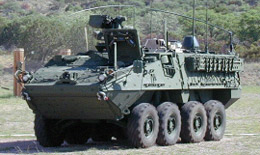The United States Armed Forces are the military forces of the United States. The armed forces consist of six service branches: the Army, Marine Corps, Navy, Air Force, Space Force, and Coast Guard. All six armed services are among the eight uniformed services of the United States.
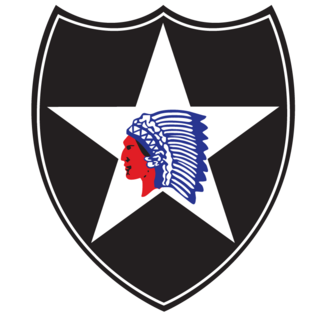
The 2nd Infantry Division ("Indianhead") is a formation of the United States Army. Since the 1960s, its current primary mission is the pre-emptive defense of South Korea in the event of an invasion from North Korea. There are approximately 17,000 soldiers in the 2nd Infantry Division, with 10,000 of them stationed in South Korea, accounting for about 35% of the United States Forces Korea personnel. Denoted the 2nd Infantry Division-ROK/U.S. Combined Division (2ID/RUCD), the division is augmented by rotational Brigade Combat Teams (BCTs) from other U.S. Army divisions.

The Stryker is a family of eight-wheeled armored fighting vehicles derived from the Canadian LAV III. Stryker vehicles are produced by General Dynamics Land Systems-Canada (GDLS-C) for the United States Army in a plant in London, Ontario. It has four-wheel drive (8×4) and can be switched to all-wheel drive (8×8).
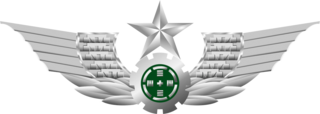
The People's Liberation Army Ground Force is the land-based service branch of the People's Liberation Army and the largest and oldest branch of the entire Chinese armed forces. The PLAGF can trace its lineage from 1927 as the Chinese Red Army; however, it was not officially established until 1948.

The brigade combat team (BCT) is the basic deployable unit of maneuver in the U.S. Army. A brigade combat team consists of one combat arms branch maneuver brigade, and its assigned support and fire units. A brigade is normally commanded by a colonel (O-6) although in some cases a brigadier general (O-7) may assume command. A brigade combat team contains combat support and combat service support units necessary to sustain its operations. BCTs contain organic artillery training and support, received from the parent division artillery (DIVARTY). There are three types of brigade combat teams: infantry, Stryker, and armored.
Reconnaissance, surveillance, and target acquisition (RSTA) groups the tasks of reconnaissance, surveillance and target acquisition conducted by the Department of Defense. RSTA supports military operations at a strategic, operational, or tactical level, either by dedicated RSTA forces or those which possess the capability.

The 4th Brigade, 2nd Infantry Division ("Raiders") is an inactive Stryker Brigade Combat Team (SBCT) of the United States Army. The brigade was activated at Fort Lewis, Washington on 1 June 2006 by reflagging the 2nd Stryker Cavalry Regiment. The 4th Stryker Brigade had the distinction of being the last U.S. Army combat brigade to serve in support of Operation Iraqi Freedom. The brigade deployed three times in support of the War on Terror, to Iraq from 2007–2008 and from 2009–2010, and to Afghanistan from 2012–2013 before inactivating in March 2014.

The reorganization plan of the United States Army was implemented from 2006 to 2016 under the direction of the Brigade Modernization Command. This effort formally began in 2006 when General Peter Schoomaker was given the support to move the Army from its Cold War divisional orientation to a full-spectrum capability with fully manned, equipped and trained brigades; this effort was completed by the end of 2016. It has been the most comprehensive reorganization since World War II and included modular combat brigades, support brigades, and command headquarters, as well as rebalancing the active and reserve components.

The M1126 Infantry Carrier Vehicle (ICV) is an armored personnel carrier and part of the Stryker family of vehicles (derived from the Canadian LAV III/Swiss MOWAG Piranha IIIH 8x8) used by the United States Army and Royal Thai Army. Models with the double V-hull upgrade are known as the M1256 ICVV.

The M1127 Reconnaissance Vehicle (RV) is a wheeled armored personnel carrier in the Stryker family, developed and produced by General Dynamics Land Systems Canada (GDLS-C) and is currently in service with the US Army.

The M1131 Fire Support Vehicle (FSV) of the Stryker series provides automated enhanced surveillance, target acquisition, target identification, target tracking, target designation, position location and communications functionality. Targets will be transmitted instantly to the fire support system and shooter. Models with the double V-hull upgrade are known as the M1251 FSVV.

The Medical Evacuation Vehicle (MEV) are assigned from the Battalion Aid Station for Battalion-sized units, and dedicated to each of the company-sized elements of the unit and provide treatment for serious injury and advanced trauma cases. Models with the double V-hull upgrade are known as the M1254 MEVV.

The United States Army Armor School is a military training school located at Fort Moore, Georgia. Its primary focus is the training of United States Army soldiers, non-commissioned officers, warrant officers, and commissioned officers. It also trains for equipment handling, including the M1 Abrams, the Bradley Fighting Vehicle, and the Stryker Mobile Gun System. The Armor School moved to Fort Benning in 2010 as part of the United States Base Realignment and Closure program.
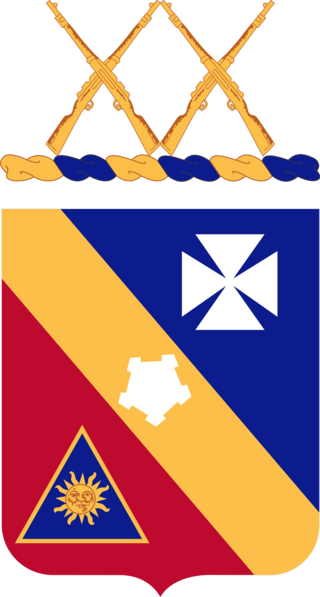
The 20th Infantry Regiment is a United States Army infantry regiment. Currently only the 5th Battalion of the 20th Infantry still exists. Stationed at Joint Base Lewis-McChord and part of the 1st Stryker Brigade Combat Team, 2nd Infantry Division, 5-20 Infantry was one of the original battalions selected to take part in the testing and fielding of the U.S. Army's then-new Stryker vehicle. During the Vietnam War, elements of the regiment carried out the My Lai massacre.

The 81st Stryker Brigade Combat Team is a modular mechanized infantry brigade of the United States Army National Guard based in Washington, Oregon and California. On 9 July 2015 it was announced that the 81st Brigade would convert from being an Armored BCT to a Stryker BCT.

M1134 Anti-Tank Guided Missile Vehicle is a U.S. anti-tank missile carrier that is an armored fighting vehicle from the Stryker family of vehicles. As the primary tank destroyer system of the US Army's Stryker Brigade Combat Team (SBCT), the M1134 ATGM Vehicle reinforces the SBCT's infantry battalions, reinforces the SBCT reconnaissance squadron and provides long-range direct fire. Models with the double V-hull upgrade are known as the M1253 ATVV.

The structure of the United States Army is complex, and can be interpreted in several different ways: active/reserve, operational/administrative, and branches/functional areas.

The 56th Stryker Brigade Combat Team (SBCT), 28th Infantry Division, also known as the Independence Brigade, is a brigade combat team of the Pennsylvania Army National Guard and has its headquarters located at Horsham Air Guard Station in Willow Grove, Pennsylvania.

The Infantry Branch is a branch of the United States Army first established in 1775.
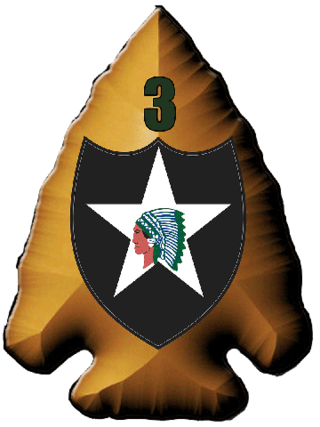
The 3rd Stryker Brigade Combat Team, 2nd Infantry Division is an inactive Stryker Brigade Combat Team of the United States Army's 2nd Infantry Division.
